
| myArmoury.com is now completely member-supported. Please contribute to our efforts with a donation. Your donations will go towards updating our site, modernizing it, and keeping it viable long-term.
Last 10 Donors: Anonymous, Daniel Sullivan, Chad Arnow, Jonathan Dean, M. Oroszlany, Sam Arwas, Barry C. Hutchins, Dan Kary, Oskar Gessler, Dave Tonge (View All Donors) |
| Author |
Message |
Richard Fay

|
 Posted: Mon 29 Jan, 2007 2:43 pm Post subject: Posted: Mon 29 Jan, 2007 2:43 pm Post subject: |
 |
|
| Randall Moffett wrote: | Richard,
John de Botiler looks like some pretty antiquated armour for the time period. Are they sure his effigy is contemporary with his date? By that decade in the 14th most english effigies have more..... armour. It is of course possible to have been mainly in mail but I would imagine most knights would have more armour by the inventoires I have seen from the opening of the 14th.
It may be worth looking at the gothic eye website has fantastic archive or effigies from this era.
RPM |
Randall,
Antiquated armour was definitely used by the "fringe" areas of Europe, including the areas of Wales, Scotland, and Ireland. You tend to see much more mail in use in these areas up to the mid 14th century. Note that the de Botiler incised slab is from Glamorgan, Wales. His "lighter" equipment could reflect what was used in Wales at the time. Someone had suggested to the English at one point that they adopt the lighter equipment of the Welsh raiders so they could more effectively counter the guerilla-type tactics used by the Welsh.
There is a Welsh effigy in a photo in the Osprey Campaign book Poitiers 1356: the Capture of a King that is apparently of 14th century date, but the warrior wouldn't look out of place on a late 13th century battlefield. He wears a gambeson over a mail hauberk, with padded gauntlets.
The Scots also tended to use antiquated armour compared to their English neighbors. The effigy of Sir James Douglas in Lanarkshire is contemporary with the incised slab of de Botiler, circa 1335. The earl is shown in rather simple equipment consisting of a mail coif with a circlet or arming band to support a helmet, a mail hauberk an mail chausses. He has long, voluminous surcoat, and a belt decorated with metal plaques or round stiffeners. He carries a rather large shield for the date, which may indicate a lack of plate armour.
I think we may be used to seeing only the top-of-the-line armour on the brasses and effigies of the great lords. Many warriors had to make due with less. actually, even with the English brasses and effigies, you can sometimes see varying degrees of plate worn with mail. The Hastings brass, for instance, shows the lower legs protected only by mail at the same time that hastings' contemporaries often adopted demi-greaves (like on two figures in the compartments alonside Sir Hugh) or full greaves (the figures from the monument of lady Percy in Beverley Minster, died 1330, apparently show both). There was more variety and variation even in each country than is sometimes realized.
I have no reason to doubt that armour shown on the de Botiler slab was indeed used at the given date.
By the way, I have looked at the Gothic Eye web site in the past. It does have a decent amount of images.
EDIT: I just tried to find the Gothic Eye web site. It apparently no longer exists or, if it still does exist, exists under a different name.
| Quote: |
By the 2-3 decade of the 14th almost all the major parts of armour more or less existed. Many parts had been around for fifty years before that (poleyns, couters, greaves, gorgets {though it may be some other rigid materials often}, Coat of plates, gauntlets, etc. By 1320 inventories of knights rarely do not list a healthy supply of plate bits. Blair states that you rarely come across one w/out a COP after 1320. By the 1330's it is required wear for Men at Arms by Edward III. |
England may have been a bit behind the continent when it came to the general adoption of plate armour. In Armies and Warfare: the English Experience by Michael Prestwich, the author claims that Jean le Bel commented on the old-fashioned nature of English armour in 1327. They apparently had no or little plate armour at that date, at least as observed by le Bel, and wore only antiquated hauberks topped with great helms.
Of course, more plate was added as the 14th century progressed, and by the time of Poitiers most of the knights and men-at-arms would have been protected mostly by plate. Some of this plate was obscured by the coat armour or jupon, making it hard to pin down it's exact shape.
| William Knight wrote: |
Also, the Met suit is reconstructed, but not very accuarately, so it'd be a poor guide to how armour looked (the fauld of solid plates and the funky one-piece spaulders are particuarly dubious). |
William,
I was presenting the Met armour as more of a general guide than a guide to the details. Perhaps I shouldn't have included it, since the details are questionable. I wanted to include something other than period art, so maybe I got a bit too carried away.
"I'm going to do what the warriors of old did! I'm going to recite poetry!"
Prince Andrew of Armar
|
|
 |
 |
Greg Coffman

|
 Posted: Mon 29 Jan, 2007 3:08 pm Post subject: Posted: Mon 29 Jan, 2007 3:08 pm Post subject: |
 |
|
As pointed out earlier, the sword was a side arm while various pole arms would be the primary weapons. Even longswords would be side arms. Also, the spear was still a very important weapon and should not be relegated to second-class polearm.
For the word of God is living and active. Sharper than any double-edged sword, it penetrates even to dividing soul and spirit, joints and marrow; it judges the thoughts and attitudes of the heart.
-Hebrews 4:12
|
|
  |
 |
Richard Fay

|
 Posted: Mon 29 Jan, 2007 4:03 pm Post subject: 14th century English armour Posted: Mon 29 Jan, 2007 4:03 pm Post subject: 14th century English armour |
 |
|
Hello again!
I found a really great site that has many images of 14th century English armour, having images of the brasses and effigies from 1277 (John D'Abernoun), through to 1407 (Nicholas Hawberk).
Here's a link to the web site:
http://www.themcs.org/armour/14th%20century%20armour.htm
The pictures may take a bit to load, but they are worth it.
I hope they don't mind if I present a few for discussion. I wanted to show some early 14th century effigies and brasses, to compare to the incised slab of John de Botiler. Some of these are within ten years or so of de Botiler, and show a similar lack of plate. A few are more advanced, with more plate. I also wanted to show a few that help visualize the evolution of 14th century English armour.
The first is the effigy of John Bouchier, who died in 1329. Notice that he is protected mostly in mail. He has something around his knees, probably padded cuisses, and maybe poleyns. He doesn't appear to have any other plate on his limbs.
The second is the effigy of Hugh Bardolph, of circa 1330. Again, except for the knees, Bardolph's limbs appear to be protected mostly by mail. The chest area on this effigy is interesting; it may represent a cuirie or some other form of breastplate worn over the surcoat, unless it is the surcoat bloused over the belt but worn tight against the chest. In the photo, it does appear smoother than the skirts of the surcoat.
The third is the brass of Robert be Bures, who died in 1331. Again, de Bures appears mostly in mail, except for elaborately engraved poleyns. The possible date for the de Bures brass is only four years prior to the date given to the de Botiler slab.
The fourth is the effigy of Nicholas de la Beche, who died in 1348. Notice that this knight's armour is much more advanced than those of the earlier knights. De la Beche wears a bascinet and has ample plate on his arms (the legs are apparently missing). He has a tight-fitting surcoat, laced up the side, over his body, obscuring what armour may lay beneath.
The fifth is the effigy of Reginald Cobham, who died in 1361. Notice the surcoat has given way to the tight-fitting, short-skirted jupon. Note also that this effigy is painted, something they all probably exhibited in period. The paint enables one to make out the splinted or brigandine cuisses, as well as other details often obscured. Cobham has a belt of plaques around his hips and a garter around his leg.
The sixth is the effigy of Thomas Cawne, who died in 1374. Note the full extent of the plate on the limbs, and the jupon worn over the body. Note also the belt of plaques around his hips.
The seventh and last is the brass of Edward Dalynrugge, who died in 1386. The armour is roughly similar to that seen in the Cawne effigy, with a few stylistic differences.
There are a lot more at the web site I found these. Check it out! 
 Attachment: 45.12 KB Attachment: 45.12 KB

John Bourchier died 1329.
©2006 The Medieval Combat Society
 Attachment: 55.52 KB Attachment: 55.52 KB

Hugh Bardolph circa 1330.
©2006 The Medieval Combat Society
 Attachment: 102.81 KB Attachment: 102.81 KB

Robert be Bures died 1331.
©2006 The Medieval Combat Society
 Attachment: 61.42 KB Attachment: 61.42 KB

Nicholas de la Beche died 1348.
©2006 The Medieval Combat Society
 Attachment: 68.04 KB Attachment: 68.04 KB

Reginald Cobham died 1361.
©2006 The Medieval Combat Society
 Attachment: 56.82 KB Attachment: 56.82 KB

Thomas Cawne died 1374.
©2006 The Medieval Combat Society
 Attachment: 98.72 KB Attachment: 98.72 KB
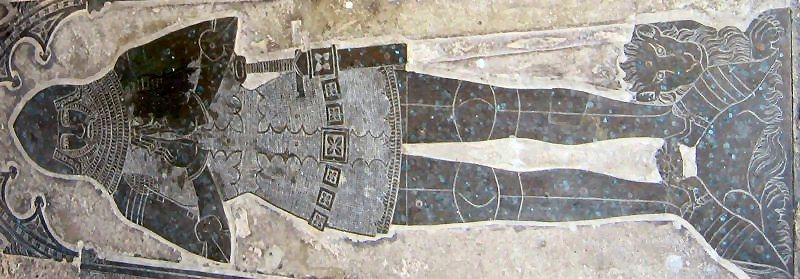
Edward Dalynrugge died 1386.
©2006 The Medieval Combat Society
"I'm going to do what the warriors of old did! I'm going to recite poetry!"
Prince Andrew of Armar
|
|
 |
 |
Richard Fay

|
 Posted: Mon 29 Jan, 2007 5:09 pm Post subject: A couple more English brasses... Posted: Mon 29 Jan, 2007 5:09 pm Post subject: A couple more English brasses... |
 |
|
Hello again!
Here a couple more English brasses of the 14th century. These are both from the early 14th century. I wanted to show these as examples of a more advanced armour than that shown on the de Botiler slab. These are roughly contemporary (actually, a bit earlier). It helps to show the variety of armour worn in England at the time. There was no standardization, and some knights wore more plate than others.
The first two images show the brass of Sir William Fitzralph, who died in 1323. I've added the coloured one because some of the details are washed out in the first image. You can see the plates strapped over the knights limbs, features lacking in de Botiler and some of his contemporaries. However, take away the gutter-shaped plates, and what you're left with is a harness very similar to the simpler harness consisting mostly of mail.
The other brass is that of Sir John D'Abernoun the Younger, who died in 1327. He has a surcoat shortened in the front (sometimes called a cyclas) that reveals multiple layers of protection. D'Aubernoun wears an aketon or gambeson, with a mail hauberk over it, and another outer garment that's either a coat-of-plates (the modern interpretation by scholars like David Nicolle) or a decorated gambeson (the older interpretation by scholars like Charles Henry Ashdown and Charles ffoulkes, and the one I tend to prefer based on Jean le Bel's comments regarding the antiquated nature of English armour and the apparent presence of "quilting lines" in the depiction of the garment). He also wears plate protection on his limbs, and has a bascinet. The D'Aubernoun brass certainly shows a more advanced armour than that shown on the de Botiler slab and other contemporary effigies. However, just because this more advanced armour appears by circa 1327 does not mean all knights wore this up-to-date equipment. Many effigies point to the fact that English armour could be old-fashioned in the early 14th century.
I hope this was of interest!
Stay safe!
 Attachment: 10.9 KB Attachment: 10.9 KB
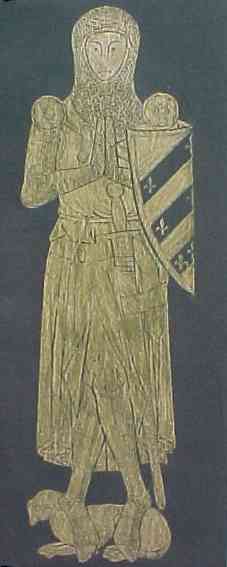
Sir William Fitzralph, died 1323.
 Attachment: 10.73 KB Attachment: 10.73 KB

Sir William Fitzralph, coloured.
 Attachment: 7.07 KB Attachment: 7.07 KB
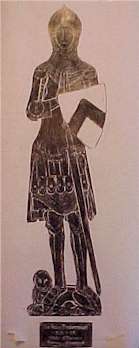
Sir John D'Abernoun the Younger died 1327
"I'm going to do what the warriors of old did! I'm going to recite poetry!"
Prince Andrew of Armar
|
|
 |
 |
Randall Moffett

|
 Posted: Tue 30 Jan, 2007 1:19 am Post subject: Posted: Tue 30 Jan, 2007 1:19 am Post subject: |
 |
|
Richard,
I am sure in some places plate did lag. I still have a hard time believing a knight in full mail with just perhaps polyrns and a COP after 1320 though. I look through inventories on a fairly common basis as I have the benefit of inventories being part of what I do full time. By 1330's even bakers and weavers in their inventories fairly often have parts of plate armour. Most of the inventories of knights I have gone through more often than not have plate armour. The question would be to compare the knight in the effigy to the inventory (if both exist). From the number of plate armour I have seen listed though I find it hard to believe most knights by the onset of the 100 years war did not own a fairly full amount of plate. Some have substancial inventories of armour.
Now perhaps personal preferences are involved. Lighten the leg or arm slightly by not wearing a greave or vambrace, possible. Economics certainly are part. poor kngihts could indeed have less plate than someone of more wealth, even outside the knightly class. There are a number of factors involved as well but I still think it would be uncommon to have someoen just in a cOP and poleyns after 1320-1330 in england.
Be careful with Jean le Bel. He was very biased as often are his countrymen toward english (yes remember the fights habitual between his countrymen's troops and the English). The continent was likely ahead as they were closer to early centers of production and in their inventories pre 1300 much rigid armour is seen. Though I wager the largest reason he wrote what he did was the continental superiority complex. If you ever read his work it becomes clear he had some views of the English that are biased and somewhat unfair. I think they were perhaps somewhat behind but I doubt they were that far behind.
NOOOOOOOOOOOOOOOOOOOOO!!!!!!!!! The Gothic Eye is GONE!!! I loved that website. I was just on it in early january
I think. How sad. I wish I would have saved more effigies....
Thanks for all the cool info Richard,
RPM
|
|
  |
 |
Richard Fay

|
 Posted: Tue 30 Jan, 2007 8:39 am Post subject: Posted: Tue 30 Jan, 2007 8:39 am Post subject: |
 |
|
| Randall Moffett wrote: | Richard,
Now perhaps personal preferences are involved. Lighten the leg or arm slightly by not wearing a greave or vambrace, possible. Economics certainly are part. poor kngihts could indeed have less plate than someone of more wealth, even outside the knightly class. There are a number of factors involved as well but I still think it would be uncommon to have someoen just in a cOP and poleyns after 1320-1330 in england. |
Randall,
Some of the effigies and brasses may indicate an earlier armour than the date the knight died, depending on when the monument was made, and what sort of harness the knight and/or artists chose to depict the departed wearing. However, if we use the brasses and effigies as guides to what may have been current, you will see a mixture of knights wearing plate and mail and those that wear mostly mail. I only presented a few of the many effigies on the Medieval Combat Society web site. I highly recommend that you check it out; there are many effigies there that are seldom shown in the popular works on arms and armour. There seems to have been more variety than is often implied by books on the subject; it's written in stone, as it were!
I understand your point about inventories, and it's a valid point. Certainly the presence of plate armour pieces on an inventory list points to the fact that that particular knight owned plate armour pieces. However, we can't ignore the evidence of the effigies and brasses. Some show mostly mail, while others at the same time show much more plate.
I think some of the surrounding nations, Scotland and Wales, certainly lagged behind England. It took wealth to purchase the most up-to-date armour, and this was often lacking in these areas. Also, the fighting styles were different, more "guerilla" style warfare than set-piece battles and sieges. Lighter armour in these regions may have been a matter of choice, not just necessity.
Inventories are perfectly valid pieces of evidence to use, I just think we have to use them in conjunction with other sources. I could also present (and maybe I will) manuscript images from around the 1320s that show mostly mail as a defence. There are some good examples of this in the British Library's on-line image library. The Manesse Codex is another example.
Are there any knights that you've seen inventories of that also have surviving effigies or brasses? Perhaps you could match the inventories to the monument. You would probably find the the knight owned more equipment than what's seen on the monument. I think they often owned more than one "kit", as it were.
Stay safe!
"I'm going to do what the warriors of old did! I'm going to recite poetry!"
Prince Andrew of Armar
|
|
 |
 |
Richard Fay

|
 Posted: Tue 30 Jan, 2007 9:50 am Post subject: early-mid 14th century armour images... Posted: Tue 30 Jan, 2007 9:50 am Post subject: early-mid 14th century armour images... |
 |
|
Hello again!
I found a few various manuscript illuminations depicting knights and warriors from the early-mid 14th century. These all came from the British Library's on-line image catalogue.
The first image depicts Galahad and Gawain in tournament, from La Queste del Saint Graal, France, circa 1316. Granted, it's a bit earlier than the 1320's and 30's, but note the complete lack of plate armour for the limbs. The surcoats hide any possible plate body armour, but the limbs are protected only by mail.
The second image depicts Guinevere besieged in a tower, from La Mort le Roi Artus, again a French manuscript of circa 1316. The style of the armour is the same as in the previous image, indeed they were probably produced in the same place. Note again the lack of plate. Some of the warriors do wear early bascinets or cervellieres, a few perhaps with visors. One knight wears what appears to be a visored sugar loaf great helm.
The third image leaps ahead to the second quarter of the 14th century, sometime after 1325 or thereabout. It depicts the capture of Acre, from the French manuscript Chroniques de France ou de Saint Denis, vol. 1. Note again the lack of plate except for the one visible poleyn and shynbald. The knights are again protected mostly by mail, the body protection obscured by long surcoats.
The fourth image, the defeat of the Saracens by King Philip III, is from Croniques de Primat, a French manuscript produced after 1333. Note again the lack of plate on the limbs. The hands may be protected by separate gauntlets, or the illustrator may just have forgotten to draw in the mail "squiggles". Otherwise, the limbs are again protected mostly by mail. Compare this and the previous image to some of the contemporary English effigies and brasses.
The fifth image, Charlemagne takes the standard, is again from the Chroniques de France ou de Saint Denis, vol. 1, of the second quarter of 14th century. There are more bascinets present in this image than the previous image, but the knight's arms are again protected primarily by mail. Poleyns are plentiful; it seems almost every warrior wears plate knee protection.
The sixth image is from the Faits des Romains, illustrated by Perrin Remy and produced in Naples, circa 1340. The illumination depicts Hannibal crossing the Alps. The armour here seems oddly old-fashioned for the date, and it may indicate the artist's desire to depict something old. The warriors are clad in mail covered by long flowing surcoats. They appear to have separate plate gauntlets and poleyns, but the limbs are otherwise protected only by mail.
The seventh and final image is again from the Faits des Romains. This illumination depicts scenes from the story of Jason. Note that again the warrior is clad mostly in mail. It is very old-fashioned armour for the date the British library gives this manuscript, circa 1340, but it may be the artist's attempts to indicate an older style that was in use earlier in his life. This is just specualtion, but it's a possibility. Then again, old-fashioned armour could remain in use in some areas.
I hope these were of interest! 
Stay safe!
 Attachment: 49.45 KB Attachment: 49.45 KB
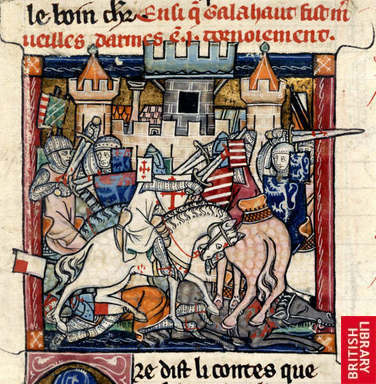
Galahad and Gawain in tournament.
© The British Library Board
 Attachment: 37.95 KB Attachment: 37.95 KB
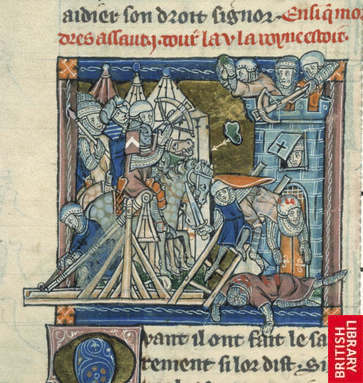
Guinevere besieged in a tower.
© The British Library Board
 Attachment: 39.77 KB Attachment: 39.77 KB
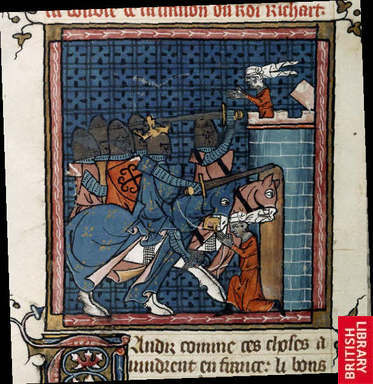
Capture of Acre.
© The British Library Board
 Attachment: 30.18 KB Attachment: 30.18 KB
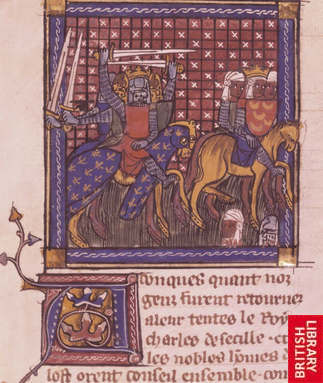
The defeat of the Saracens by King Philip III of France.
© The British Library Board
 Attachment: 58.76 KB Attachment: 58.76 KB
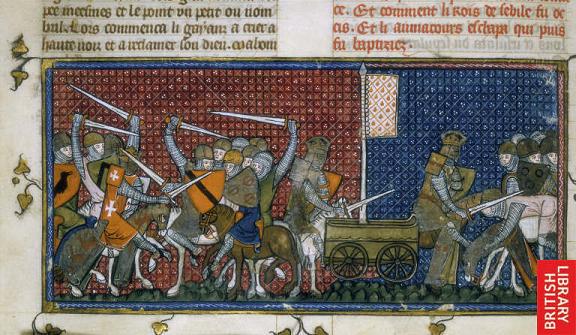
Charlemagne takes the standard.
© The British Library Board
 Attachment: 52.98 KB Attachment: 52.98 KB
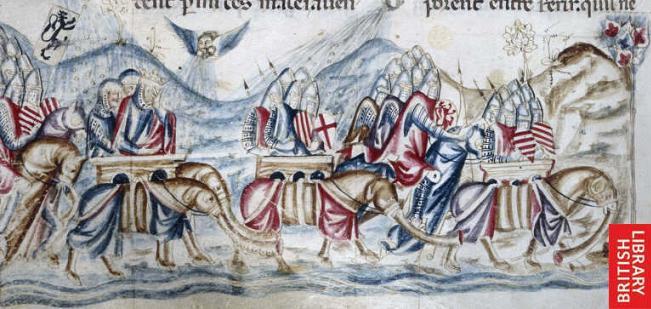
Hannibal crosses the Alps.
© The British Library Board
 Attachment: 44.52 KB Attachment: 44.52 KB
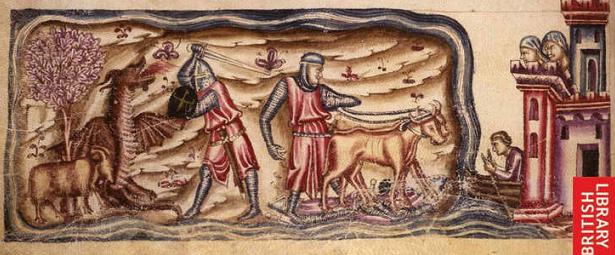
Scenes from the story of Jason.
© The British Library Board
"I'm going to do what the warriors of old did! I'm going to recite poetry!"
Prince Andrew of Armar
|
|
 |
 |
Randall Moffett

|
 Posted: Tue 30 Jan, 2007 10:32 am Post subject: Posted: Tue 30 Jan, 2007 10:32 am Post subject: |
 |
|
Richard,
In the pieces you used they all seem to indicate the artist showing antiquity BY purposly leaving out plate and showing old armour. The do the same thing with Beckett's murder often showing the armour of men a few decades or more back. There are a number of books on effigies out there as well as on artwork. It is a good source but it need be looked at very carefully. In many cases effigies are not made remotely close to the date of death, some made decades before or after. We do not know often where they exactly came from (York perhaps had a center for making them). Art History books have all sorts of ideas that are applicable and might help you out.
Alexander, J.J.G. and P. Binski. The Age of Chivalry: Art in Plantagenet England 1200-1400. 1st edn. London, 1987.
Marks, R. and N. Morgan. The Golden Age of English Manuscript Painting, 1200-1500.
London, 1981.
Sandler, L.F. Gothic Manuscripts, 1285-1385. London, 1986.
Warner, G.F. The Master of the Queen Mary Psalter. London, 1912.
I would assume inventories to be an ace opposed to artwork by the way. If they state they owned x, y and z they owned x, y and z. Legal witnesses make an oath the items exist in many cases (probate inventories) at one given and written time as well as a place.
By the way. I do think mail was by far the primary defence for most knights at the start of the 14th. I think you might think I am disagreeing when I am not. I do think the plateless knight very unlikely like I said post 1320. There is nothing that really at this point could convince me otherwise by the large number of original material I have gone over to support it.
RPM
|
|
  |
 |
Richard Fay

|
 Posted: Tue 30 Jan, 2007 11:52 am Post subject: More early-mid 14th century artwork images... Posted: Tue 30 Jan, 2007 11:52 am Post subject: More early-mid 14th century artwork images... |
 |
|
Hello again!
Randall,
I understand that artwork can be unreliable when talking an exact date. I think many effigies and brasses were made prior to the knights' deaths, so they may represent an armour earlier than the death of the knight. The date of death probably gives us a latest date that the armour may have been used. The armour probably represents an older style on most.
Manuscript images showing ancient historical events may show an older form of armour than was current, but any sense that things were "different" in ancient times than in the middle ages was embryonic at best. Many, such as the Maciejowski Bible and the Romance of Alexander in the Bodliean Library, do show armour contemporary for the date of the work. These manuscripts still show historical events, but the artists drew the figures as if they were contemporary knights and warriors.
I understand what you are saying about the inventories, but I am trying to say that there was more variety of armour styles and combinations than many believe. I'm not doubting that plate was in common use by the 1320's or 1330's, what I am trying to suggest is that it was not in universal use. Some English effigies and brasses show a good amount of plate at that time, while others do not. I don't think every knight or every non-noble man-at-arms would necessarily have the most up-to-date equipment. The great lords, the peers of the realm and such, would certainly have the most up-to-date equipment. However, keeping up with the latest styles must have been expensive, and I don't think all warriors would have discarded the older style that may have either been handed down to them or acquired in their youth.
Yes, inventories are very specific sources not really open to interpretation, whereas period art can be open to a lot of interpretation. However, the invenotires only tell us what equipment was used by those individuals the inventories were made for. They can't tell us if x,y, and z were owned by a knight not mentioned in the inventory.
In case anyone is interested, I did find more early-mid 14th century manuscript images. These are all from the National Library of the Netherlands. Again, they show mostly historical events, so they might indicate an attempt at the depiction of old-fashioned armour. However, they remain pretty consistent with the other early-mid 14th century manuscript images I posted.
The first two images are from the manuscript The Hague, KB, KA 20, the Spieghel Historiael by Jacob van Maerlant. It's dated circa 1325-1335. The first image depicts the battle between Arthur and Modred. Poleyns are present, but otherwise there is little to no plate visible.
The second image, from the same manuscript, depicts the battle of Roncevaux. Again, there are poleyns and maybe a shynbald, but no plate on the arms.
The third image is from The Hague, MMW, 10 B 21, the Rhimebible by Jacob van Maerlant, illuminated by Michiel van der Borch. It is dated 1332. It depicts the battle against the inhabitants of Jabesh. The figures wear bascinets, with at least one great helm, but no visible plate on the limbs.
The fourth and fifth images are both from The Hague, KB, 71 A 24, Les Miracles de Notre Dame, Les Vies des Peres, a Parisian manuscript dated circa 1320-40. The first image from that manuscript depicts the legend of the knight attending the mass instead of taking part in a tournament. Note again the lack of plate armour visible on the arms. The leg of the angel or saint may have a shynbald, and a definite poleyns.
The second image from Les Miracles de Notre Dame, Les Vies des Peres depicts the legend of three brothers who were knights and became criminals. Again, the knights have shynbalds and poleyns, but no plate protection on the arms.
Let me point out one thing about these images; they only show use what was obviously visible. We can assume that many of these knights wore some sort of coat-of-plates or cuiries under the outer garment. It is also possible that shynbalds/demi-greaves could be worn beneath the mail chausses. There is one German effigy, that of Margrave Rudolph IV of Baden-Durlach, who died in 1348, which shows just such an arrangement. It is quite possible that this was done earlier as well.
I hope this was of interest!
 Attachment: 68.85 KB Attachment: 68.85 KB
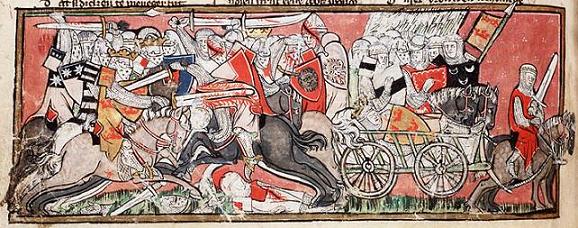
The battle between Arthur and Modred.
© Koninklijke Bibliotheek National Library of the Netherlands
 Attachment: 69.66 KB Attachment: 69.66 KB
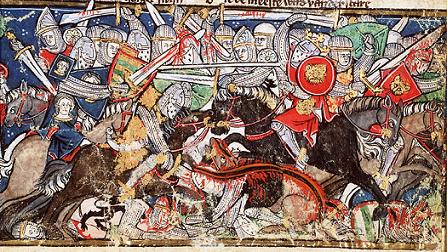
The battle of Roncevaux .
© Koninklijke Bibliotheek
 Attachment: 69.97 KB Attachment: 69.97 KB
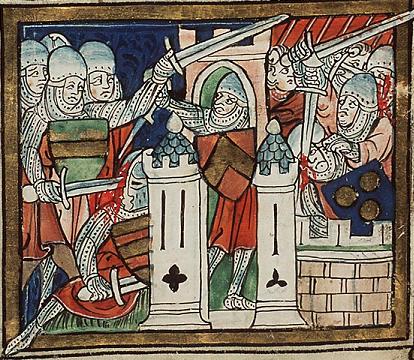
Battle against the inhabitants of Jabesh.
© Koninklijke Bibliotheek
 Attachment: 49.95 KB Attachment: 49.95 KB
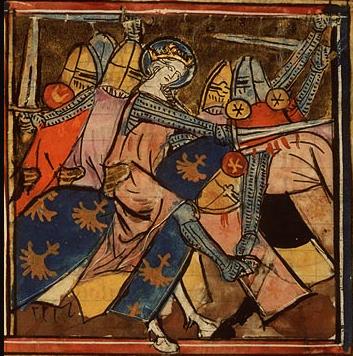
Legend of the knight attending the mass instead of taking part in a tournament.
© Koninklijke Bibliotheek
 Attachment: 71.23 KB Attachment: 71.23 KB
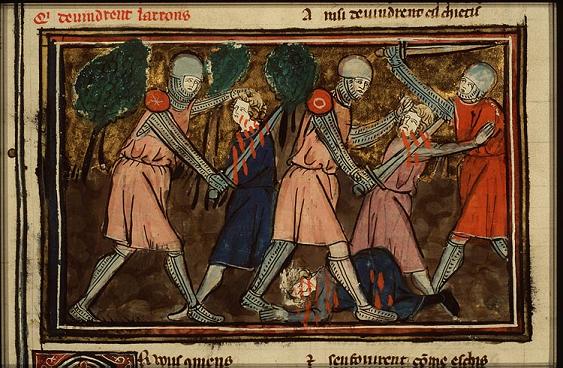
The legend of three brothers who were knights and became criminals.
© Koninklijke Bibliotheek
"I'm going to do what the warriors of old did! I'm going to recite poetry!"
Prince Andrew of Armar
|
|
 |
 |
Richard Fay

|
 Posted: Tue 30 Jan, 2007 1:49 pm Post subject: Images from the Manesse Codex... Posted: Tue 30 Jan, 2007 1:49 pm Post subject: Images from the Manesse Codex... |
 |
|
Hello again! 
I thought I would present some images from the Manesse Codex (Cod. Pal. germ. 848 Große Heidelberger Liederhandschrift, Codex Manesse) as examples of the sort of harness worn in the region of Germany/Switzerland (Zurich) in the early 14th century. This is a hard manuscript to give an exact date to; the Universitätsbibliothek Heidelberg gives it a date of 1305 to 1340. There is some sign of an evolution from mail to plate in the various images, so they probably do date across much of that spread.
The first image is folio 253v, "Der Püller". Notice that the knights are in mail hauberks with long surcoats, typical of the late 13th to the early 14th century. There is no visible sign of plate. Even the helms appear rather flat-topped.
The second image is folio 42r, "Graf Albrecht von Heigerloch". Note again the lack of plate visible on the limbs except for the figure being cut across the face. That figure may wear poleyns and even greaves or shynbalds. This may indicate a mixture of style worn at the same time. The helms certainly appear a bit more rounded than in the previous image. There are even a few early bascinets or cervellieres present.
The third image is folio 43v, "Graf Wernher von Homberg". There may be a visored helm worn by one knight on the left, but there is little to no plate visible. Note also the much lighter attire of the infantry.
The fourth image is folio 397v, "Der Dürner". This jousting scene is interesting because one of the knights wears poleyns and greaves, and the greaves are probably made of leather. His opponent apparently has only mail protecting his legs. This again may indicate a variety of styles and preferences in use at the same time. Another interesting point about this image is the presence of a gorget, and the hint of a coat-of-plates being worn by the knight on the left. It's actually clearer in the larger image; I reduced these so they would fit in my post.
The fifth image is folio 316v, "Herr Friedrich der Knecht". His armour shows some interesting differences from that in the previous images, possibly indicating slightly later armour. He wears separate mail gauntlets; a feature that also occurs on a few German effigies, such as that of Kuno von Falkenstein, circa 1343. His limbs still appear to be protected mostly with mail. Since the scene looks more like a raid (he's carrying off a maiden), perhaps he is supposed to be in lighter harness. It's certainly lighter than that of the left-hand jouster in the previous image.
The next two images, folio 361r, "Heinrich von Tettingen" and folio 359r, "Von Buwenburg", are interesting in that the armoured figures may represent non-noble warriors, perhaps mercenaries.
Notice in folio 361r that the mounted figure on the left wears separate mail gauntlets. Note also the aventail hanging down from the helmets like a curtain instead of protecting the front of the throat. Also note that nether armoured figure seems to wear leg armour. Mail could certainly be used by mercenaries and other non-noble soldiers who might not necessarily be able to afford, or wish to be burdened with the cost of, up-to-date plate armour.
In folio 359r the figure in the foreground carrying the crossbow has no armour other than his gambeson sleeve on his forearms. He again lacks leg armour, and all the armoured figures have the helmets with the curtain of mail. Again, these are probably mercenaries or some other type of non-noble soldier.
The eighth and last image is interesting because in some ways the armour seem the most advanced shown in the manuscript. It is folio 226v, "Kristan von Luppin, eine Thuring". Note the bascinet either worn over a mail coif or with it's own integral mail aventail. Note also the separate mail gauntlets. Finally, note the fully enclosed greave and poleyn worn on the knights leg.
All of these images came from the same manuscript. They obviously weren't all produced at the same time. However, a few also show variations in the same folio. There does seem to be some variation in the amount of plate worn with the mail in the early-mid 14th century, at least according to some of these images.
I hope this was of interest! 
Stay safe!
 Attachment: 40.4 KB Attachment: 40.4 KB
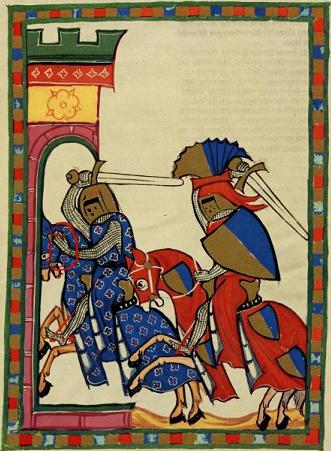
253v Der Püller
© 2004 Copyright Universitätsbibliothek
Heidelberg
 Attachment: 54.98 KB Attachment: 54.98 KB
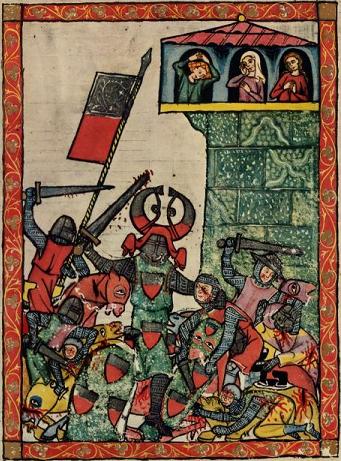
42r Graf Albrecht von Heigerloch.
© 2004 Copyright Universitätsbibliothek
Heidelberg
 Attachment: 53.45 KB Attachment: 53.45 KB
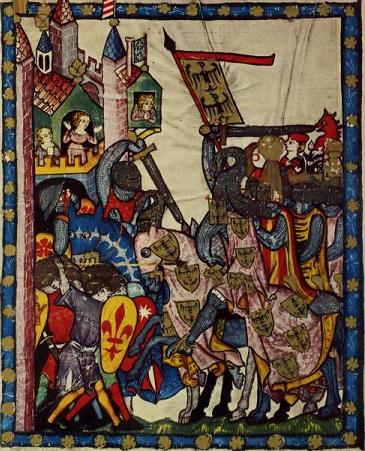
43v Graf Wernher von Homberg.
© 2004 Copyright Universitätsbibliothek
Heidelberg
 Attachment: 48.29 KB Attachment: 48.29 KB
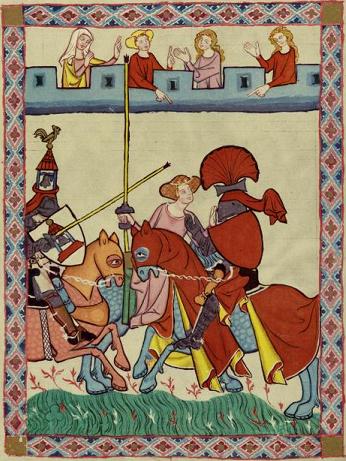
397v Der Dürner.
© 2004 Copyright Universitätsbibliothek
Heidelberg
 Attachment: 38.29 KB Attachment: 38.29 KB
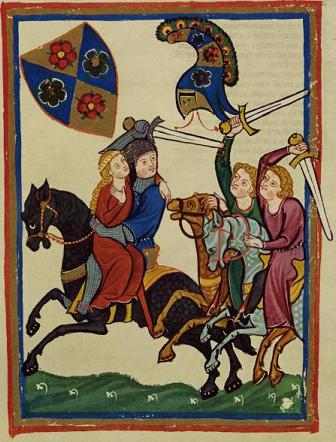
316v Herr Friedrich der Knecht.
© 2004 Copyright Universitätsbibliothek
Heidelberg
 Attachment: 39.53 KB Attachment: 39.53 KB
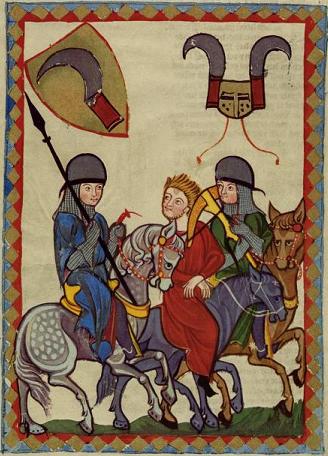
361r Heinrich von Tettingen.
© 2004 Copyright Universitätsbibliothek
Heidelberg
 Attachment: 45.11 KB Attachment: 45.11 KB
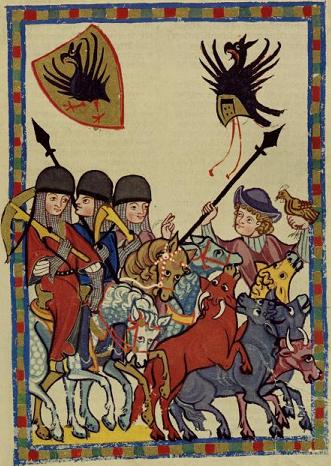
359r Von Buwenburg.
© 2004 Copyright Universitätsbibliothek
Heidelberg
 Attachment: 39.66 KB Attachment: 39.66 KB
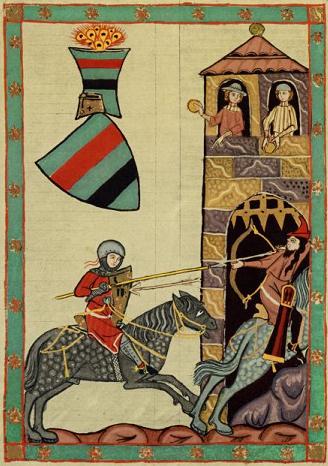
226v Kristan von Luppin, eine Thuring.
© 2004 Copyright Universitätsbibliothek
Heidelberg
"I'm going to do what the warriors of old did! I'm going to recite poetry!"
Prince Andrew of Armar
|
|
 |
 |
Randall Moffett

|
 Posted: Wed 31 Jan, 2007 4:37 am Post subject: Posted: Wed 31 Jan, 2007 4:37 am Post subject: |
 |
|
Here are two inventories of goods some men of Southampton (non-knightly class) had in their possession.
CPR EDII vol iV- 1323 'armour, yiz. plates, bascinets, collarets, gauntlets, cuisses and
other armour for the munition of sixteen men'
CPR ED II vol iv- 1324 'armour, viz. steel plates, bucinets, collarets, gauntlets, greaves,
and other armour for the munition of sixteen men.'
just two little inventories I came across today as I did my work that are interesting as they are inventories of plate armour owned by townsmen in the early 1320's. It is also interesting that in the first they have cuisses (might be padded gament ot perhaps splint type or plate as well per Blair and the second inventory does not but has greaves. It also indicates the small collections that townsmen acquired. Note though Southampton was inside the town itself not the poor but that does not need require them be the highest level of wealth either. in a few years the place 3rdish for the poll tax though.
RPM
|
|
  |
 |
Richard Fay

|
 Posted: Wed 31 Jan, 2007 10:13 am Post subject: Posted: Wed 31 Jan, 2007 10:13 am Post subject: |
 |
|
Hello all!
| Randall Moffett wrote: |
Here are two inventories of goods some men of Southampton (non-knightly class) had in their possession.
CPR EDII vol iV- 1323 'armour, yiz. plates, bascinets, collarets, gauntlets, cuisses and
other armour for the munition of sixteen men'
CPR ED II vol iv- 1324 'armour, viz. steel plates, bucinets, collarets, gauntlets, greaves,
and other armour for the munition of sixteen men.' |
Randall,
I'm not disputing the evidence from the inventories, I agree that they are rather indisputable proof of plate armour pieces being in use by that time. However, I am disputing that they are proof of universal usage. There are many of the poorer, more "fringe" areas of Europe, including areas of the British Isles, that seem to have relied on lighter armour. There seems to be less plate in places like Wales, Scotland, and Ireland in the early to mid 14th century, as well as perhaps southern France.
To suggest that everywhere in the British Isles used the same equipment is ignoring the possible variety that could be found. You even noted yourself that there is some variety in the specific pieces of plate used; one inventory includes greaves, while the other does not. Note also that a warrior kitted out in a fashion similar to the inventory sans greaves might look a bit like some of the art I posted if the collarets were worn beneath the mail. I did point out that some of these things may be hidden in period art.
Certainly a coat-of-plates and probably the cuisses (which could be padded and not scale or plate lined, as shown on some brasses of roughly the same time) would be hidden by the long surcoat. Assuming the "steel plates" and "plates" in the inventories refer to coats-of-plates, then the arms may have been protected by mail at most. I wonder, why isn't mail specifically mentioned? Was it common enough not to be mention specifically, or would non-noble warriors have gone without? Would it be included in the "other armour" category? Do you have more information regarding that issue?
Maybe we are just looking at this from different perspectives.
Stay safe!
"I'm going to do what the warriors of old did! I'm going to recite poetry!"
Prince Andrew of Armar
|
|
 |
 |
Randall Moffett

|
 Posted: Wed 31 Jan, 2007 10:36 am Post subject: Posted: Wed 31 Jan, 2007 10:36 am Post subject: |
 |
|
Richard,
I actually was just putting them up here as it fit the post theme. It did not have anything really to do with anything else. As part of my work I am researching inventories and civic accounts. I came across these as I was referencing the relation of the townsmen with the royal records and it fit the bill so to speak thats all.
As far as the back plates. I figure they likely were included with the front, especially on early COP's where they tend to be one piece. I figure it likely the same for leather torso protection and early breast/backplates. I wonder often how much certain terms actually mean. The term vambrace with rerebrace and couter together for example are a full arm harness quite clearly but the term vambrace often seems to indicate a full arm harness as well as the price would indicate it not a lone bit of armour. Plates in late 13th (perhaps) and the 14th referes to COP's. It is usually a process of elimination as they often own much gear and then plates. Very rarely is anything but plates listed. in 1358 I think Prince Edward is cleaning out his armoury and ditching huge numbers of COP's and breastplates. In this inventory it Clearly is COP's as it describes it somewhat (even fabirc and color!).
Something else perhaps is that the townsmen or men at arms in general might not even have had mail. The aketon was the required torso protection in some of Edward II's reign (along with other items- I have the list and sitation if you like). Edward III makes it aketon and COP for torso armour early in his reign (though Edward II might have done this later in his reign but I am not sure).
I do not think Scotland was that far behind england (in the lowlands- the highlands is basically a different kingdom at this point used to swell the army) but agree that it and other places were behind other places like italy, france, etc.
|
|
  |
 |
Richard Fay

|
 Posted: Wed 31 Jan, 2007 11:27 am Post subject: Posted: Wed 31 Jan, 2007 11:27 am Post subject: |
 |
|
| Randall Moffett wrote: |
I actually was just putting them up here as it fit the post theme. It did not have anything really to do with anything else. As part of my work I am researching inventories and civic accounts. I came across these as I was referencing the relation of the townsmen with the royal records and it fit the bill so to speak thats all. |
I actually appreciate that you posted that information. I think we may just be interpreting it in a slightly different fashion. I'm more interested in individual variations than broad trends. I find the slight differences in what's listed to be intriguing. I would love to read more inventories if you get a chance to post more later! 
| Quote: |
As far as the back plates. I figure they likely were included with the front, especially on early COP's where they tend to be one piece. I figure it likely the same for leather torso protection and early breast/backplates. I wonder often how much certain terms actually mean. The term vambrace with rerebrace and couter together for example are a full arm harness quite clearly but the term vambrace often seems to indicate a full arm harness as well as the price would indicate it not a lone bit of armour. Plates in late 13th (perhaps) and the 14th referes to COP's. It is usually a process of elimination as they often own much gear and then plates. Very rarely is anything but plates listed. in 1358 I think Prince Edward is cleaning out his armoury and ditching huge numbers of COP's and breastplates. In this inventory it Clearly is COP's as it describes it somewhat (even fabirc and color!). |
I think there's a bit of a communication error here, I didn't think I implied anything either way about back plates.  I was just bringing up the fact that the terms are often inexact, and made the point that if we assume plates meant coat-of-plates (which I have seen in the arms and armour literature), then there is no armour for the arms listed on the inventories. The "other armours' make me wonder what wasn't listed individually. I think if they felt it was important enough to list gauntlets (which may rarely be mail instead of plate; at least mail gauntlets were definitely used in Germany), greaves, collarets, and cuisses, then vambraces should have been mentioned. I find the lack of specific mention of vambraces to be interesting. I was just bringing up the fact that the terms are often inexact, and made the point that if we assume plates meant coat-of-plates (which I have seen in the arms and armour literature), then there is no armour for the arms listed on the inventories. The "other armours' make me wonder what wasn't listed individually. I think if they felt it was important enough to list gauntlets (which may rarely be mail instead of plate; at least mail gauntlets were definitely used in Germany), greaves, collarets, and cuisses, then vambraces should have been mentioned. I find the lack of specific mention of vambraces to be interesting.
As for back plates, it is possible that rare examples of coats-of-plates lacked back plates. There was a variation in design. One coat-of-plates from Visby, Visby Armour Number 20, only had slightly curved rectangular-shaped plates that protected only the front of the body. There are occasional images of later breastplates worn over mail without a backplate, and just crossed straps in the back (Italian, I believe). Assuming that England followed the pattern on the continent, then a few coats-of-plates may have protected only the front of the torso.
| Quote: |
Something else perhaps is that the townsmen or men at arms in general might not even have had mail. The aketon was the required torso protection in some of Edward II's reign (along with other items- I have the list and sitation if you like). Edward III makes it aketon and COP for torso armour early in his reign (though Edward II might have done this later in his reign but I am not sure). |
There are period images from Italy showing infantrymen in either doubled quilted garments or coat-of-plates worn over padded gambesons or aketons. A good example of this can be found on the wall paintings in the Castle of Sabbionara in Avio, circa 1340. There is a distinct lack of plate limb protection for most of the infantrymen. Most appear to rely on the padded garment alone for protection for their arms.
| Quote: |
I do not think Scotland was that far behind england (in the lowlands- the highlands is basically a different kingdom at this point used to swell the army) but agree that it and other places were behind other places like italy, france, etc. |
I don't necessarily agree with you on this point. Again, relying on the effigies, Scottish effigies seem to show a less advanced armour than that on the contemporary effigies and brasses in England. This may go along with the fact that Scotland was a poorer nation than its southern neighbor. I understand your questions about using effigies as evidence of use at the time of death of the subject, but I think we can relate effigies from approximately the same time to one another. As I stated earlier, the effigy of Sir James Douglas in Lanarkshire, of circa 1335, depicts the knight in a mail coif, hauberk (possibly with fingered mufflers), long surcoat, possible gambeson, and a large shield. On the other hand, the monumental brass of Sir William Fitzralph in Essex, of circa 1325, depicts the knight in a hauberk with plates strapped to his forearms and upper arms, as well as poleyns and shynbalds. His shield is also much smaller, which may be the result of the use of more plate armour than that used by Douglas. The brass of Sir John de Bacon in Suffolk, of circa 1320, shows a similar armour to that shown on Fitzralph, but the lower legs are too worn to interpret. Even given the problems of dating monumental effigies and brasses, I would suspect that the Douglas effigy and the de Bacon and Fitzralph brasses are roughly contemporary.
Of course, those Scottish nobles like the Bruces who were also of the Anglo-Norman nobility, and who held lands in England, may have been equiped in a more up-to-date fashion than others.
Stay safe!
"I'm going to do what the warriors of old did! I'm going to recite poetry!"
Prince Andrew of Armar
|
|
 |
 |
Randall Moffett

|
 Posted: Thu 01 Feb, 2007 12:12 am Post subject: Posted: Thu 01 Feb, 2007 12:12 am Post subject: |
 |
|
Richard,
No I in a round about way was in argeement on the flexibility of terms. The only saving grace with them is some tend to be fairly limited as to what they mean specific to an area and time period. Plates for example in the 15th is diffeent from plates in the 16th.
I do disagree regarding scottish armour in the lowlands. I think douglass's effigy could have been exported from england during his lifetime. If he bought it in the 1310' or 20's it very likely would be bare. In part the danger regarding scot effigies is there are fewer by far to other countries and hard to gauge. I do know in some financial records of the scottish kings (I cannot find the book at the library currently- it is reference only so someone has it.) there was reference in one of some arms owned by a douglass around 1320's which included more than mail (Bruce is also listed in the same volume so I assume it is the same Douglass). I have looked alittle at scottish effigies but found them almost fitting into a mould and think they might be the product of some place that mass produced them and sent them from a difference. It would be interesting to find out where they were made but possibly impossible. If they were behind they caugh up fairly quickly as by Nevill's cross the lead scots seem to have been armed fairly similar to the english knights.
RPM
|
|
  |
 |
Richard Fay

|
 Posted: Thu 01 Feb, 2007 10:05 am Post subject: Posted: Thu 01 Feb, 2007 10:05 am Post subject: |
 |
|
Hi Randall! 
I agree it's hard to use the Scottish effigies as a guide in terms of general trends, because there are so few of them, and many are apparently in bad shape. I suppose Douglas's effigy could be as early as 1310. If it's in the 1320's, though, it may support the idea of less plate worn by some in the 1320's. I definitely agree that the Scottish nobles may wear more plate by Neville's Cross, that was in 1346, contemporary with Crecy.
As an example of what I mean by a variety of combinations, look at the various figures depicted on the Hastings brass, 1347. There is a fascimile of it, taken in a similar way to that of proofing an etched metal plate, in Henry Trivick's The Picture Book of Brasses. There is also a pretty exact drawing of it in The Knight in Medieval England 1000-1400 by Peter Cross, and an apparent rubbing of it in English Medieval Knight 1300-1400 by Christopher Gravett. The Gravett Osprey book also shows close-up views of two of the subsidiary figures.
The central large figure of Sir Hugh Hastings wears gutter-shaped plates on his forearms and upper arms, with rondels at the elbow and shoulder. He wears a gorget around his throat, and a rather globular visored bascinet with aventail on his head. His thighs are protected by studded cuisses (probably of brigandine or coat-of-plates type construction), and there are rather conical poleyn on his knees. However, his lower legs are apparently protected by mail alone; no plates are visible. A small "heater" shield hangs on his arm.
The subsidiary figures include a compartment for Henry Plantagenet, Lord Ralph Stafford, and other noblemen. They all show slight variations in the pieces shown and the amount of plate used.
The figure of Henry Plantagenet, Duke of Lancaster, holds a great helm in his hand. He wears a collar or tippet of large rings, possibly large mail inks. On his arms he has laminated spadlers at the shoulders, gutter-shaped rerebrace on the upper arm, couter with a slight rudimentary wing at the elbow, gutter-shaped vambrace on the lower arm, and possibly a gauntlet on the hand. One his legs he wears studded cuisses, conical poleyns, shynbalds and sabatons over mail chausses. Note that he has slightly more plate, and of a slightly different style, to that shown worn by Sir Hugh.
The figure of Lord Ralph Stafford has a conical bascinet with a visor and either an aventail or coif. He may were full vambraces, but it's hard to tell (the mail may be worn or missing in this small figure's arms). Lord Ralph's legs are protected in a similar manner to the Duke of Lancaster's legs. Lord Ralph has a shield hanging by no visible means around the area of his waist. It's a small heater just like that held by Sir Hugh.
Two other subsidiary figures show yet more variation. One may wear fully closed vambraces and greaves. Another may also were fully-closed arm protection with demi-greaves over chausses on his legs. This same figure wears a gorget, similar to that shown worn by Sir Hugh, and wears a kettle-hat, perhaps over a bascinet. This figure also has a small heater shield.
All figures wear a shortened surcoat, about half-thigh length, with their coats-of-arms on the front. The surcoat is rather tight around the chest, then fuller in the skirts. It's a style somewhere between the long, flowing surcoat split up the front and the much shorter and tighter jupon.
Note the variation present on one individual brass. Obviously the engraving must have taken some time to complete, but I think the figures can be considered to be roughly contemporary. This one important piece of artwork may indicate a fairly wide range of variety and combinations in use at approximately the same time. They don't all wear the same pieces, and they don't all wear all the pieces depicted on the whole brass. This is the point I've been trying to make; just because all these different pieces existed at the same time doesn't mean that every knight used every piece. There was some variation in the actual pieces used.
Below, I've included the images from Trivick of Sir Hugh Hastings, the Duke of Lancaster, and Lord Ralph Stafford.
 Attachment: 58.48 KB Attachment: 58.48 KB
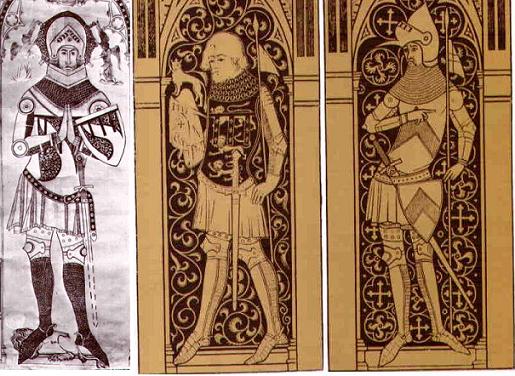
Figures from the Hastings brass: Sir Hugh Hastings, the Duke of Lancaster, Lord Ralph Stafford.
"I'm going to do what the warriors of old did! I'm going to recite poetry!"
Prince Andrew of Armar
|
|
 |
 |
Randall Moffett

|
 Posted: Thu 01 Feb, 2007 11:32 am Post subject: Posted: Thu 01 Feb, 2007 11:32 am Post subject: |
 |
|
Richard,
I agree there was alot of variation. Another good source is the window in Tewksbury Abbey (The one with the Earl of Gloucester). It was made mid 14th (likely early 1340). One has fully enclose limb plate armour, including gorget, next to the right has full greaves and gauntlets but nothing but mail on the arms and a mail coif. Third to the right is in full plate armour on his limbs but his left arm (shield arm?) nothing but a gauntlet and couter and mail. Last man no plate arm armour but front guttered greaves,gauntlets and a plate gorget.
Who knows what the artist is trying to describe in the work? If the men really fought w/out plate arm defences? Now in fact I doubt the arms and armour associated with the four individuals has much to do with the men they are of in the stain glass besides a name. It may be just to make them different or to show variation but in the end how do we know the artist had even met all these people, let along seen their armour? I feel that way about alot of effigies and artwork in general. The first portrait we know of I think is Jean the good of France. Some effigies look almost identical which you likely have noticed. How do we know there was not a walmart-like warehouse where effigies were built or sold? Stainglass is a bit different but there are clearly schools for writing texts and illuminations that can be seen in comparison. It may just be regional similarities in art but just an idea I came across that had alot of potential and explained some of the strange similarities.
Cheers,
RPM
|
|
  |
 |
Richard Fay

|
 Posted: Thu 01 Feb, 2007 12:14 pm Post subject: Posted: Thu 01 Feb, 2007 12:14 pm Post subject: |
 |
|
Hello all!
Randall,
Yes, the Tewkesbury Abbey window of circa 1340 is another good example of period art showing variations. There is a decent black and white photo of the window in English Medieval Knight 1300-1400 by Christopher Gravett, and a very nice colour photo in Stephen Bull's An Historical Guide to Arms and Armour. I actually mentioned it in an earlier thread as a possible depiction of scale aventails.I'm not sure that the armour is contemporary with the figures; I think it may show past patrons of the abbey, but the armour should be roughly contemporary with the construction of the window. I think, since nobles often patronized such efforts, that they would want to be shown in their own equipment, or at least in appropriately-looking equipment. I doubt these rich and powerful men would have accepted something that showed them in poor, out-dated armour.
I don't think much artistic license crept into these period depictions (effigies and brasses), they seem realistic, and many of the pieces match surviving examples and pieces mentioned in inventories and such. Some of the pieces are obviously of a different form than the few pieces we have that survive from the period, but I think the effigies and brasses especially can give us a good idea about form. Some aren't perfect, but many show realistic-looking details that could depict actual historical armour. The most the artist's seem to so is to adjust some things, like ailettes, so they show up in a two-dimensional depiction.
To get back to the original topic of this thread, I found some very interesting images of the Churburg breastplate of circa 1390. This cuirass shows hints of it's lineage from the earlier coats-of-plates, the plates are held together by being rivetted to a leather backing. It's a nice representation of the sort of armour that might be encountered in the late fourteenth century. Other breastplates of the time were sometimes covered in velvet.
 Attachment: 47.36 KB Attachment: 47.36 KB
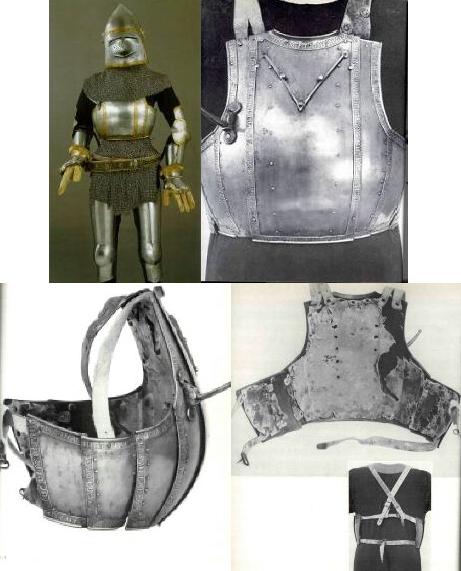
Churburg armour, circa 1390.
"I'm going to do what the warriors of old did! I'm going to recite poetry!"
Prince Andrew of Armar
|
|
 |
 |
Chad Arnow
myArmoury Team


|
 Posted: Sun 11 Feb, 2007 1:24 pm Post subject: Posted: Sun 11 Feb, 2007 1:24 pm Post subject: |
 |
|
| Allan Senefelder wrote: | | The Met suit was deassesioned and sold on ebay 2 years ago I believe. It is made up of a fair percentage of pieces fabricated in the Met armour dept. if I remeber right. |
As of earlier today, the "14th century" Chalcis Hoard-comprised "Corazzina" harness was still in its vitrine at the Met.  Seeing it in person, though, it just doesn't look quite right. Seeing it in person, though, it just doesn't look quite right.

ChadA
http://chadarnow.com/
|
|
    |
 |
|
|
You cannot post new topics in this forum
You cannot reply to topics in this forum
You cannot edit your posts in this forum
You cannot delete your posts in this forum
You cannot vote in polls in this forum
You cannot attach files in this forum
You can download files in this forum
|
All contents © Copyright 2003-2024 myArmoury.com — All rights reserved
Discussion forums powered by phpBB © The phpBB Group
Switch to the Basic Low-bandwidth Version of the forum
|

